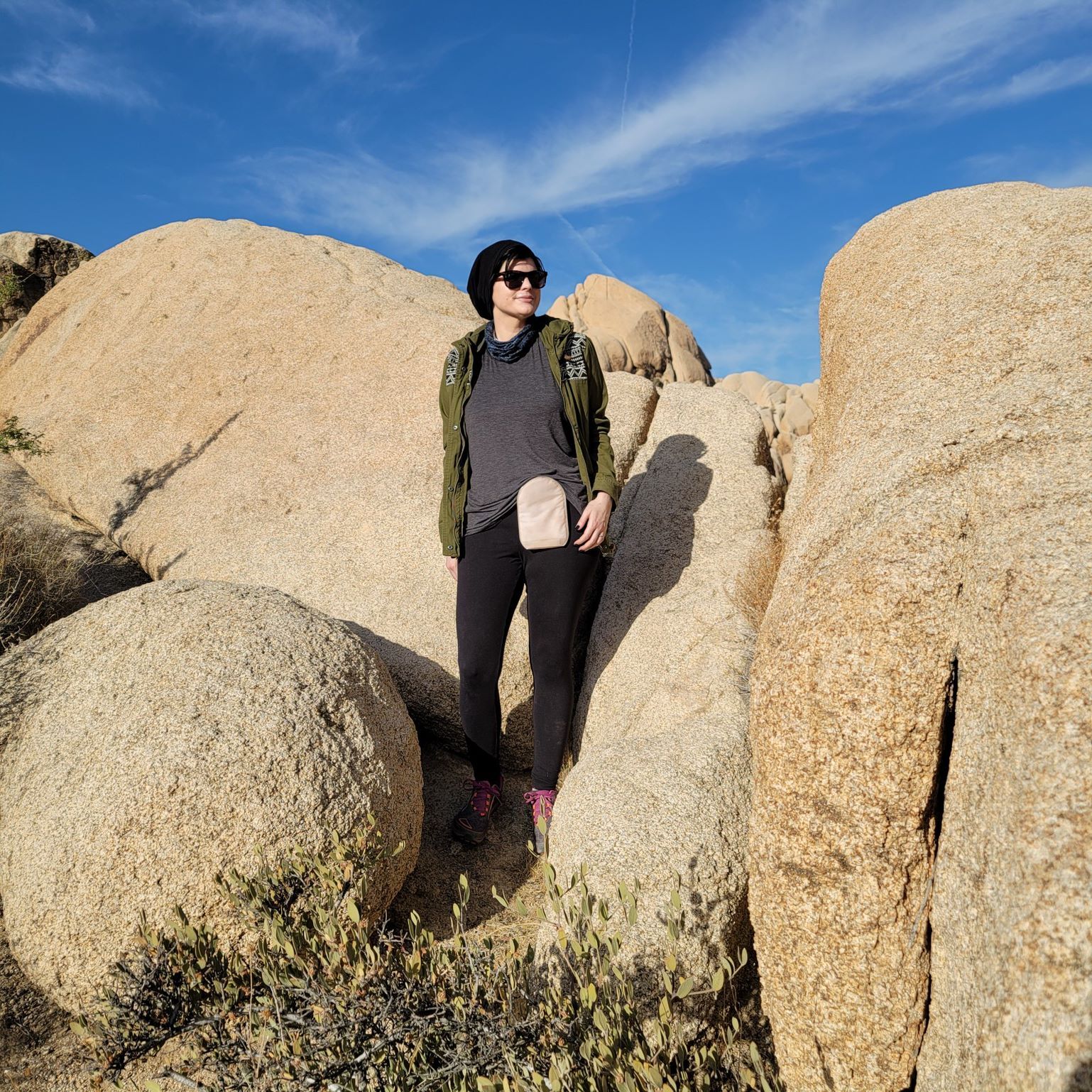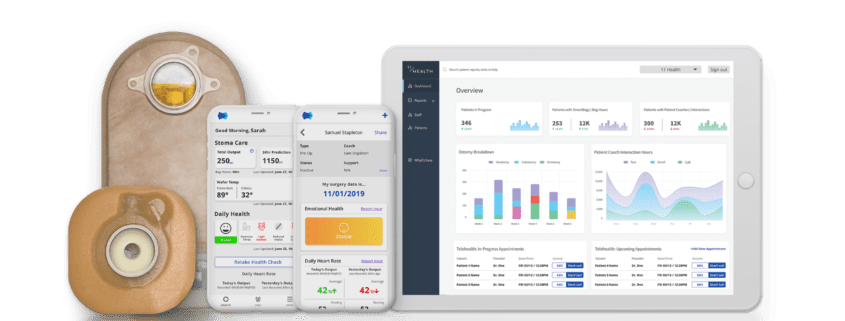How Coaching & Technology Reduced Hospital Readmissions Rates
A research study about the benefits of perioperative self-management support for ostomates
Ostomates are not only dealing with intestinal concerns but are also at risk for a multitude of complications. Data shows that 38% of ostomy patients find themselves back in the emergency room or  being admitted within the first 90 days post operatively [1]. This is one of the highest rates of readmission when compared to other types of surgery. The most common cause for re-admission is dehydration, at approximately 40% of post ileostomy readmissions [2]. We also know that 84% of ostomy patients develop skin issues. The causes of these can be chemical, mechanical, or microbial, and possibly avoidable. Ostomates also have significantly increased healthcare costs, especially when affected by peristomal skin complications, and leakage [2]. It is known that 25% of ostomates develop renal failure within two years. The complications these patients encounter require 7x more outpatient visits than the average patient. And 29.1% of ostomates experience readmission which costs approximately $16,000 per patient [1]. These statistics show that specialized care for these patients is imperative to improving patient outcomes in this patient population.
being admitted within the first 90 days post operatively [1]. This is one of the highest rates of readmission when compared to other types of surgery. The most common cause for re-admission is dehydration, at approximately 40% of post ileostomy readmissions [2]. We also know that 84% of ostomy patients develop skin issues. The causes of these can be chemical, mechanical, or microbial, and possibly avoidable. Ostomates also have significantly increased healthcare costs, especially when affected by peristomal skin complications, and leakage [2]. It is known that 25% of ostomates develop renal failure within two years. The complications these patients encounter require 7x more outpatient visits than the average patient. And 29.1% of ostomates experience readmission which costs approximately $16,000 per patient [1]. These statistics show that specialized care for these patients is imperative to improving patient outcomes in this patient population.
A recent study published by the American Society of Colon and Rectal Surgeons shows how one company, 11 Health and Technologies, is utilizing a novel care approach to improve the quality of life and outcomes in this type of patient. The company developed alfred: SmartCare, a unique care model designed to meet the specialized need of ostomates. The program consists of a SmartBag and SmartWafer, mobile application, patient coaches (who were/are also ostomates, trained to support this type of patient) and the nursing team. The patient wears the SmartBag and SmartWafer, which submits data to the mobile application and clinical dashboard. The data is visible to the patient, their coach, the nursing team and the patient’s clinicians to be used to identify trends and abnormalities in the values. The patient can see how much output they have expressed and what the temperature is of their peristomal skin. These data points can help to curtail oncoming hydration issues or infections. When abnormalities are identified, the coach can work with the patient to provide education and can escalate issues to the nursing team for medical guidance.
In the study, the outcomes of 66 new ostomates from 19 different states were monitored for the first 30 post-operative days. The study showed that close monitoring of ostomy output volume as well as perioperative self-management support can significantly reduce the rate of hospital readmissions in the first 30 days after ostomy surgery.
Patients and healthcare providers should be open to the use of innovative programs that use remote monitoring along with telehealth, as they can be beneficial in improving the outcomes of patients in the immediate post-operative period.
To read the full study, visit the Diseases of the Colon & Rectum online at: https://journals.lww.com/dcrjournal/Citation/2020/12000/Improved_30_Day_Surgical_Outcomes_in_Ostomates.17.aspx
Editor’s note: This article is from one of our digital sponsors, 11 Health and Technologies. Sponsor support along with donations from readers like you help to maintain our website and the free trusted resources of UOAA, a 501(c)(3) nonprofit organization.
[1] Tyler, J. A., Fox, J.P., Dharmarajan, S., Silviera, M. L., Hunt, S. R., Wise, P. E., Mutch, M. G. (2014). Acute health care resource utilization for ileostomy patients is higher than expected. Diseases of the Colon & Rectum, 57(12), 1412-1420.
[2] Justiniano, C. F., Temple, L. K., Swanger, A. A., Xu, Z., Speranza, J. R., Cellini, C., Salloum, R. M., & Fleming, F. J. (2018). Readmissions With Dehydration After Ileostomy Creation: Rethinking Risk Factors. Diseases of the colon and rectum, 61(11), 1297–1305. https://doi.org/10.1097/DCR.0000000000001137
[3] Taneja, C., Netsch, D., Rolstad, B. S., Inglese, G., Eaves, D., Oster, G (2019). Risk and economic burden of peristomal skin complaints following ostomy surgery. Journal of Wound, Ostomy and Continence Nursing, 46(2), 143-149.
[4] Fearn, Robert I. M.D., M.R.C.P.1,2; Gorgun, Emre M.D.3; Sapci, Ipek M.D.3; Mehta, Saahil N. M.D.2; Dinh, Binh B.S.2; Yowell, Quinn V. M.S.2; Eisenstein, Samuel M.D.4 (2020). Improved 30-Day Surgical Outcomes in Ostomates Using a Remote Monitoring and Care Management Program: An Observational Study. Diseases of the Colon & Rectum: December 2020 – Volume 63 – Issue 12 – p e581-e586.







In my humble opinion, a worthy project for someone to undertake is the following. Volunteer ostomates should be recruited to produce professionally done videos of all aspects of being an ostomate including but not limited to emptying a bag, both at home and in a public restroom, changing the appliance in such settings, traveling with an ostomy, dealing with peristomal skin….. I am sure that there are lots of these topics which confront a new ostomate. Most videos that I have observed are good up to a point, but ar generally self produced and could use some professional touches. Those of us who live with ostomies are the ones with the experience to demonstrate, but the vast majority of us do not have the expertise to produce a good video. I have seen videos depicting the events described above, that have been produced with nurses using props, etc. These don’t, it seems to me, help much. Let’s face it, in my now nearly 4 years of living with an ostomy, I have changed my appliance roughly 500 times. How many nurses, even trained stoma nurses have changed an appliance that many times? And when it comes to emptying the bag, the numbers are even more telling. Further more, I am a relative newbie when I compare myself with those who have lived with an ostomy for 10, 20, 30 years. If such a resource was produced and made available to ostomy patients from the get-go, I think it would go a long way towards helping them get used to their new ”normal”. As a further suggestion, a cadre of volunteer ”experts” could aid in the training of stoma nurses. I live in a relatively small community of 24,000 in a rural setting, but we have a junior college with a nursing program. I have reached out to the school to offer myself as a ”teaching adjunct” but likely due to the current pandemic, I have not been contacted with an answer to my suggestion. I realize that presenting myself as a ”expert” is a bit of an overstatement, but having lived, successfully, with my stoma for 4 years gives me the right and perhaps the responsibility to ”give back” to the community. In closing, I am more than grateful to my surgeon who was fantastic and to his staff for giving me life and a good start on my journey. I am 77 and 4 years ago, the prospects of saying that were pretty slim. If there is anyone, out there, that thinks my idea has merit, feel free to contact me and maybe an idea could turn into reality.
Philip, I agree! Seeing some one change a bag or how to flush the bag would be such a great learning experience to a new ostomate. Or how to solve the powder application on a sore spot. The junior college would be very fortunate to have you share your knowledge.
Greetings Phillip,
My name is Ron, I am a 17 year paraplegic, 71 years old and have a daily bowel care routine of which I pay an LVN ( out of pocket ) to help in my daily care 5 days a week. My wife assists me those two other days. My bowel care really puts a damper on my freedom and not to mention the out of pocket costs. Earlier this year I contacted a Doctor whose specialty is Ostomy surgery.
After reviewing the paper work and all what he said I may experience I decided to look into an organization that supports folks that live with Ostomy and what their experiences are.
Paraplegia, self transfers on and off bed, onto my chair and onto the drivers seat. There is a lot of body movement. Can that body movement and stress cause additional complications?
Am I opening a can of worms?
Regards
Ron
Ron, I am 80 yrs. young, have a colostomy for 23 years due to Rectal Cancer. I do gentle yoga and other stand up exercises which does not interfere with the ostomy. I do have a peristomal hernia (near the stoma). I wear a special hernia belt all day to keep the hernia in place and prevent it from enlarging. I personally don’t see that your movements would hinder having an ostomy or its function. I would strongly advise you to visit a WOCNurse (Wound Ostomy Continence Nurse) who can help you decide and mark where the stoma would be placed on your abdomen by the surgeon. This would ensure that your daily movements would not interfere with the placement and function of the ostomy. Often times, a surgeon places the ostomy too close to the waistline and that can hinder how clothing fits and seat belts, etc. But a nurse can spend time helping with the placement before surgery once she/he knows of your daily movements. It seems to me an ostomy would make your life easier; help with bowel care and perhaps prevent some movements that now are necessary for the bowel care. I am not an expert, but am active in my ostomy support groups so hear many helpful tips and the help of the UOAA.
Right now many ostomy support groups are having their meetings by Zoom. That would be a really good way for you to ask questions and have some more feed back from ostomates “live” from your home! This has been a real help to those who are home bound. The UOAA website has a place for you to find a support group near you or any place for that matter in the US. You simply put in your zipcode to find the nearest one. Usually there is a telephone no. or email address where you can request to join a Zoom meeting of that support group. Our support groups are most friendly and caring so don’t be shy.
Good luck. Stay well. Get going.
Sincerely,
Sue Rizvi
I am an Occupational Therapist who works with a young client who recently received an ostomy and has home nursing to care for the device as well as help from her Mom. She is a young adolescent and I have been seeing her for a number of years for other developmental issues. How can I best support her in growing forward and becoming more independent in self-care?
Thanks,
Tara, OT